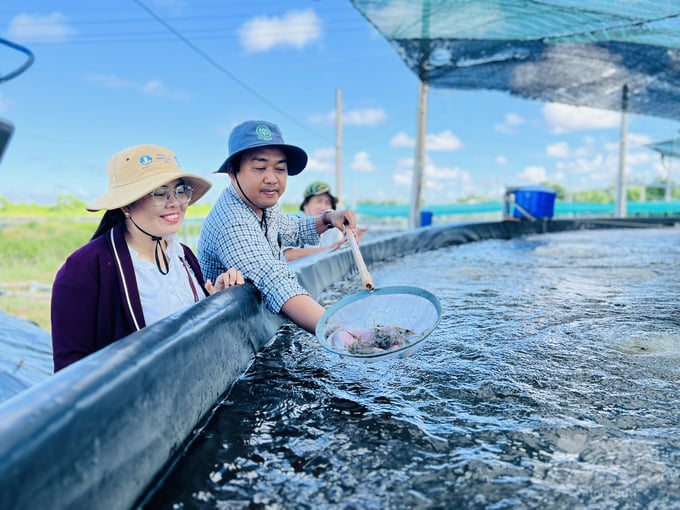April 16, 2025 | 06:53 GMT +7
April 16, 2025 | 06:53 GMT +7
Hotline: 0913.378.918
April 16, 2025 | 06:53 GMT +7
Hotline: 0913.378.918

Nearly 320 ha of shrimp ponds in Soc Trang are infected with acute hepatopancreatic necrosis disease (AHPND). Photo: Trong Linh.
According to the Department of Animal Health, in the first nine months of 2024, acute hepatopancreatic necrosis disease (AHPND) appears in 112 communes, 43 districts in 15 provinces and cities. The total area of shrimp farms affected by the disease is over 1,009 ha. Compared to the same period in 2023, the disease’s influence in the shrimp industry decreased both in terms of scope (down 6.67%) and area (down 13.22%).
There is 239 ha of black tiger shrimp farming area suffered from the disease, and 770 ha in the case of whiteleg shrimp. The infected shrimp are mainly at the stage of 25 - 40 days after stocking. The diseased area of intensive and semi-intensive farming models is 956 ha, and the diseased area of extensive farming, improved extensive farming and shrimp - rice models is 53 ha. Soc Trang is the province with the largest diseased shrimp farming area with nearly 319 ha, accounting for 37.79% of the total diseased area, followed by Tra Vinh and Bac Lieu.
Acute hepatopancreatic necrosis is caused by bacteria and can be treated. However, treatment for shrimp is often expensive and ineffective (because in the process shrimp often stop eating), so proactive disease prevention measures are crucial to prevent the disease from occurring.
Following the notice of the Department of Animal Health, the bacteria Vibrio parahaemolyticus carrying the PirA and PirB virulence genes have circulated in many farming areas, appearing in shrimp hatcheries, commercial shrimp farms, and farming models. Most localities under monitoring test positive for acute hepatopancreatic necrosis disease.
Vibrio parahaemolyticus can stay strong in the aquatic environment, so it is very important to treat the water supply to destroy it. Farmers also need to treat the water source in diseased shrimp ponds before discharging into the environment to limit the spread of pathogens throughout the farming area.
As the active monitoring results have detected acute hepatopancreatic necrosis disease in shrimp larvae, farmers should prioritize using shrimp larvae from disease-free facilities and pay more attention to shrimp seeds that have been quarantined or those with clear origin.

White spot syndrome (WSS) has affected more than 1,000 ha of shrimp ponds nationwide, mainly spotted in the Mekong Delta. Photo: Trong Linh.
Nearly 280 ha of shrimp farms in Kien Giang caught WSS
Not only acute hepatopancreatic necrosis, shrimp farmers in the Mekong Delta have also suffered heavy losses due to white spot syndrome (WSS). According to the Department of Animal Health, white spot disease occurred in 144 communes, 48 districts in 16 provinces and cities in the first nine months of 2024.
A total of over 1,034 ha of shrimp farming area is affected by the disease. The area of diseased black tiger shrimp farming is 467 ha, and the area of diseased whiteleg shrimp is 568 ha. Shrimp are mainly infected 35 - 60 days after stocking.
Shrimps infected with white spot syndrome are mainly seen in intensive and semi-intensive farming models, totaling an area of 702 ha. As for extensive, improved shrimp farming models and shrimp-rice models, the affected area is 332 ha.
Kien Giang has recorded the largest shrimp farming area affected by WSS. The province suffered a loss of 279 ha, accounting for nearly 27% of the total diseased area, followed by Tra Vinh, Soc Trang, Ben Tre, and Bac Lieu.
White spot syndrome is caused by a virus, so antibiotics should not be used during the treatment process. Active disease prevention measures are considered vital to achieve maximum efficiency. Particularly at the time of changing seasons, when the weather experiences diverse movements and the temperature drops, it is necessary to manage the water environment in the pond well. Crustaceans and shrimp naturally carry pathogens and are at high risk of infection, so farmers need to pay more attention to the infraorder of crustaceans (crabs, red‐jointed fiddler crab, etc.).
White spot syndrome virus has been circulating in many farming areas, appearing in shrimp hatcheries, commercial shrimp farms, farming models and natural crustaceans. Farmers therefore need to treat water sources in diseased shrimp ponds carefully before discharging into the environment to limit the spread and dissemination of pathogens throughout the farming area.
Translated by Samuel Pham

(VAN) On April 15, Minister of Agriculture and Environment Do Duc Duy hosted Ms. Dechen Tsering, Regional Director of the United Nations Environment Programme (UNEP) Asia-Pacific.

(VAN) The Ministry of Agriculture and Environment and the Ministry of Industry and Trade, in coordination with relevant ministries and agencies, have established five inter-sectoral inspection teams to conduct inspections in 10 provinces and cities.

(VAN) South Africa commits to working with Vietnam to conserve biodiversity, promote a just energy transition, manage marine areas, and develop sustainable aquaculture.

(VAN) Vietnam Agency of Sea and Islands has proposed that the MAE organize the Vietnam Sustainable Maritime Economy Development Forum in 2025.

(VAN) Deputy Prime Minister Nguyen Hoa Binh has just signed a decision approving the Project to organize administrative units at all levels and build a two-tier local government structure.

(VAN) This is an important goal that the UN-Habitat organization of the United Nations is implementing in Son La, aiming to respond to climate change and reduce disaster risks.

(VAN) In the context of increasingly complex climate change, the International Organization for Migration (IOM) is committed to supporting Vietnam in developing safe and sustainable migration models.